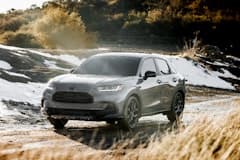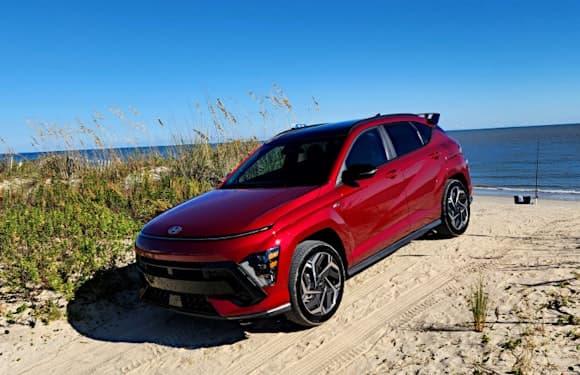
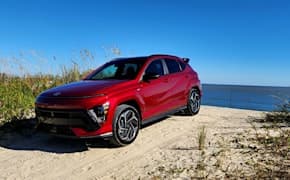
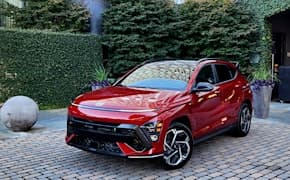
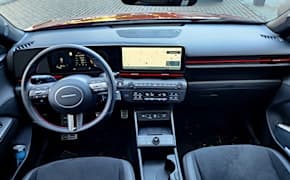
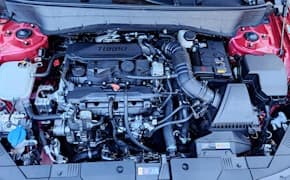
Show all photos
Summary
The 2024 Hyundai Kona is a completely new vehicle this year, entering its second generation. It’s now roomier inside and just as efficient as before, making it one of our top choices for the small crossover-SUV segment.
- Upscale interior feel
- Roomy seating
- Barely adequate powertrains
- Weird shifter position
- Completely new vehicle for a new generation of the Kona
Engine
Horsepower
MPG
Max Seating
Basic Warranty
Verdict - Is the 2024 Hyundai Kona a Good SUV?
The 2024 Hyundai Kona is all-new for this model year, having undergone a complete revamp that includes more interior space and a new look. We like the look and feel of this new Kona, though the larger footprint means it’s not as maneuverable or urban-friendly as its previous design. We think most buyers will not find that too problematic once they’ve experienced this new Kona.
The interior of the 2024 Kona sees a radical amount of change. Headroom, legroom, and cargo space are all improved. The back seats are now six-footer friendly, unlike the previous model, and the cargo space is smarter with a more accessible floor.
Compared to most in the small crossover segment, the new Kona has a lot to offer. It’s more upscale on the inside, quieter in the cabin, and just about right on the road while driving. It’s a little larger than some, and just about as fuel efficient as most. All in all, a compelling offering for the segment.
Test Drive Notes
With over four decades of doling out trusted automotive advice and extensive vehicle knowledge, both behind the wheel and under the hood, Car Talk's founder and original Tappet Brother Ray Magliozzi shares his first-hand experience test driving the Hyundai Kona.
Overall Car Talk Award
Car Talk researchers have tested this vehicle and decided to award it a 8.3 out of 10 based on our years of expertise and stringent criteria.
8.3/10
We have reviewed all of the following aspects of this vehicle.
8/10
8/10
9/10
Hyundai Kona vs. The Competition
The small crossover-SUV segment is a popular one with consumers and a competitive one amongst automakers. The Kona faces strong competition, but many rivals trend towards the cheaper side of things and none are as new in design for 2024.
Hyundai Kona vs Chevrolet Trailblazer
The Trailblazer is a good little crossover, commensurate in size with the previous-generation Kona. That makes it more compact and maneuverable and gives its turbocharged engine more umph for the buck. The Kona, however, has a better interior in every respect and more technology by default.
Hyundai Kona vs Honda HR-V
The Honda HR-V is one of the few vehicles we’ve panned in recent reviews. It has little going for it in comparison to the Hyundai Kona. And that’s about all we have to say about that.
Hyundai Kona vs Kia Niro
The Kia Niro is the closest competitor to the Hyundai, having been introduced as all-new for the 2023 model year. The Niro and Kona share many things, including a size bump for this new generation. The Kia is less refined than the Hyundai, though, but does offer a lower price point.
How Much Does a 2024 Hyundai Kona Cost?
The base price for a new Kona is about $25,500, but most buyers are going to be happier with the more well-equipped SEL model, which is about $1,000 more.
The table below shows the most common trim levels and how much they will run you.
SE
SEL
N Line
Limited
What's New for the Hyundai Kona in 2024?
The Kona is completely new for the 2024 model year, marking the second generation of the small crossover. The Kona is now larger, has more interior space, and includes more technology than its predecessor.
In terms of model options, the Hyundai Kona keeps the same trim levels it had before, including hybrid and fully electric models. As well as the sport-themed N model. Another thing that does not change is the engines powering the non-electric versions of the Kona. The 1.6-liter turbocharged four-cylinder remains largely unchanged for the new 2024 Kona.
What does change, significantly, is the Kona’s size. The new 2024 Kona is almost six inches longer than the outgoing model and slightly taller as well. All of this added size means a roomier interior with better rear seat legroom and a more usable cargo space.
Performance - How Does the Hyundai Kona Drive?
There are four powertrain choices for the 2024 Hyundai Kona: a standard gasoline, a hybrid, and a battery-electric. The electrified models will be available later in the 2024 model year, so our drive impressions are based solely on the gasoline-only models.
Both a 2.0-liter four-cylinder engine and continuously variable transmission (CVT) and a 1.6-liter turbocharged four-cylinder engine with an eight-speed automatic are found in the gasoline variants of the Kona. The former is in the standard trim lineup while the latter is in the N Line and Limited trim options.
The standard 2.0L and its CVT are good enough to power the Kona efficiently, but without any verve to speak of. For most buyers, though, that’s secondary to the low cost and everyday drivability of the vehicle. We have few complaints about this setup, other than its struggles to get up to highway speeds quickly and a lack of any kind of fun factor while driving. That’s probably not a dealbreaker for most buyers in this segment.
The turbocharged engine is a lot more interesting. Hyundai dropped the dual-clutch transmission it had before and is instead using a slower-shifting, but far less clunky standard-shift automatic. This combination is more comfortable and sportier to drive, but is not what we’d call race car material. For those wanting a little more pep, the 190 horsepower from this turbo engine is a good jump over the 147 of the 2.0L. It does make the drive more enjoyable.
Safety - How Safe is the Hyundai Kona?
Because the 2024 Kona is all-new, crash test ratings are only available in small chunks. Complete testing by the National Highway Traffic Safety Administration (NHTSA) has been published, but the Insurance Institute for Highway Safety (IIHS) has not yet published full results.
The NHTSA gives the 2024 Hyundai Kona a five-star crash test rating.
The IIHS has, as of this writing, not published any crash test results for the 2024 Kona. Given Hyundai’s track record with the IIHS so far, though, we expect the results to be better than average.
Reliability & Quality - Is the Hyundai Kona Reliable?
Most consumer grading outlets for reliability mark the Kona as about average for reliability. The new 2024 model is untested, of course, but with powertrains that carry over from the previous generation, it can be assumed that in most mechanical respects, it will be the same.
We tend to give companies like Hyundai that offer big warranties more preference than to those with smaller warranties and similar reliability outlooks. What’s more, Hyundai’s warranties follow the vehicle, so used models still under manufacturer’s warranty windows do not lose that warranty when repurchased.
Features - What Hyundai Kona Options Are Worth It?
There are a lot of standard features in the new Kona, which is nice to see as the small crossover segment is a busy one. Some features are coming soon, via over-the-air updates to the infotainment system in this new Hyundai, while others are still optional.
We’d recommend heated and vented seating and the heated steering wheel. The upgraded audio system in the Limited and N Line models is also very good. Most of the things that are most desirable on today’s market are standard in the 2024 Kona, though. All of the advanced safety systems, including safe-exit alerts, lane centering assistance, and front cross-traffic warning are there. Some of these are segment exclusive to the Kona.
Exterior colors
Abyss Black Pearl
Ultimate Red
Atlas White
Mirage Green
Denim Blue Pearl
Cyber Gray
Ecotronic Gray
Soultronic Orange Pearl
Neoteric Yellow
Interior colors
Black, cloth
Gray, cloth
Warranty - What is the Hyundai Kona Warranty?
Hyundai offers one of the industry’s best warranties, beating most rivals in this regard.
- Basic: 5 years / 60k miles
- PowerTrain: 10 years / 100k miles
- Hyundai offers extended warranties for certified pre-owned cars
- If buying used look at our best extended warranties or Certified Used warranties
 Hyundai Kona | ||
| Basic | 5 yr./ 60,000 mi. | 3 yr./ 36,000 mi. |
| Powertrain | 10 yr./ 100,000 mi. | 5 yr./ 60,000 mi. |
| Corrosion | 7 yr./ unlimited mi. | 5 yr./ unlimited mi. |
New or Used - Is Hyundai Kona Worth Buying Used?
Used models of the Hyundai Kona are going to be the previous generation model. This model was alright for the segment, but lacks most of the refinement and comforts of the 2024 model. On the used market, the previous-gen Kona will likely be a great bargain if you can live with its cramped rear seat and shorter headroom.
